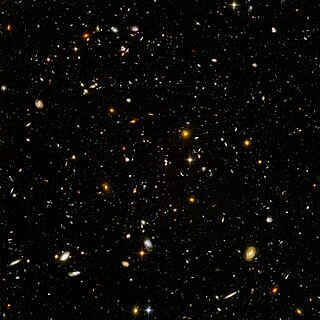A googolplex is the large number 10 googol , or equivalently, 1010100 or 1010,000,000,000,000,000,000,000,000,000,000,000,000,000,000,000,000,000,000,000,000,000,000,000,000,000,000,000,000,000,000,000,000,000. Written out in ordinary decimal notation, it is 1 followed by 10100 zeroes; that is, a 1 followed by a googol of zeroes. Its prime factorization is 2googol ×5googol.
In 1920, Edward Kasner's nine-year-old nephew, Milton Sirotta, coined the term googol , which is 10100, and then proposed the further term googolplex to be "one, followed by writing zeroes until you get tired". [1] Kasner decided to adopt a more formal definition because "different people get tired at different times and it would never do to have Carnera [be] a better mathematician than Dr. Einstein, simply because he had more endurance and could write for longer". [2] It thus became standardized to 10(10100) = 1010100, due to the right-associativity of exponentiation. [3]
A typical book can be printed with 106 zeros (around 400 pages with 50 lines per page and 50 zeros per line). Therefore, it requires 1094 such books to print all the zeros of a googolplex (that is, printing a googol zeros). [4] If each book had a mass of 100 grams, all of them would have a total mass of 1093 kilograms. In comparison, Earth's mass is 5.97 × 1024 kilograms, [5] the mass of the Milky Way galaxy is estimated at 1.8 × 1042 kilograms, [6] and the total mass of all the stars in the observable universe is estimated at 2 × 1052 kg. [7]
To put this in perspective, the mass of all such books required to write out a googolplex would be vastly greater than the mass of the observable universe by a factor of roughly 5 × 1040.
In pure mathematics, there are several notational methods for representing large numbers by which the magnitude of a googolplex could be represented, such as tetration, hyperoperation, Knuth's up-arrow notation, Steinhaus–Moser notation, or Conway chained arrow notation.
In the PBS science program Cosmos: A Personal Voyage , Episode 9: "The Lives of the Stars", astronomer and television personality Carl Sagan estimated that writing a googolplex in full decimal form (i.e., "10,000,000,000...") would be physically impossible, since doing so would require more space than is available in the known universe. Sagan gave an example that if the entire volume of the observable universe is filled with fine dust particles roughly 1.5 micrometers in size (0.0015 millimeters), then the number of different combinations in which the particles could be arranged and numbered would be about one googolplex. [8] [9]
1097 is a high estimate of the elementary particles existing in the visible universe (not including dark matter), mostly photons and other massless force carriers. [10]
The residues (mod n) of a googolplex, starting with mod 1, are:
This sequence is the same as the sequence of residues (mod n) of a googol up until the 17th position.

The decimal numeral system is the standard system for denoting integer and non-integer numbers. It is the extension to non-integer numbers of the Hindu–Arabic numeral system. The way of denoting numbers in the decimal system is often referred to as decimal notation.

A numeral system is a writing system for expressing numbers; that is, a mathematical notation for representing numbers of a given set, using digits or other symbols in a consistent manner.

The universe is all of space and time and their contents. It comprises all of existence, any fundamental interaction, physical process and physical constant, and therefore all forms of matter and energy, and the structures they form, from sub-atomic particles to entire galactic filaments. Since the early 20th century, the field of cosmology establishes that space and time emerged together at the Big Bang 13.787±0.020 billion years ago and that the universe has been expanding since then. The portion of the universe that we can see is approximately 93 billion light-years in diameter at present, but the total size of the universe is not known.
Scientific notation is a way of expressing numbers that are too large or too small to be conveniently written in decimal form, since to do so would require writing out an inconveniently long string of digits. It may be referred to as scientific form or standard index form, or standard form in the United Kingdom. This base ten notation is commonly used by scientists, mathematicians, and engineers, in part because it can simplify certain arithmetic operations. On scientific calculators, it is usually known as "SCI" display mode.
English number words include numerals and various words derived from them, as well as a large number of words borrowed from other languages.
Large numbers, far beyond those encountered in everyday life—such as simple counting or financial transactions—play a crucial role in various domains. These expansive quantities appear prominently in mathematics, cosmology, cryptography, and statistical mechanics. While they often manifest as large positive integers, they can also take other forms in different contexts. Googology delves into the naming conventions and properties of these immense numerical entities.
Graham's number is an immense number that arose as an upper bound on the answer of a problem in the mathematical field of Ramsey theory. It is much larger than many other large numbers such as Skewes's number and Moser's number, both of which are in turn much larger than a googolplex. As with these, it is so large that the observable universe is far too small to contain an ordinary digital representation of Graham's number, assuming that each digit occupies one Planck volume, possibly the smallest measurable space. But even the number of digits in this digital representation of Graham's number would itself be a number so large that its digital representation cannot be represented in the observable universe. Nor even can the number of digits of that number—and so forth, for a number of times far exceeding the total number of Planck volumes in the observable universe. Thus Graham's number cannot be expressed even by physical universe-scale power towers of the form , even though Graham's number is indeed a power of 3.
A binary number is a number expressed in the base-2 numeral system or binary numeral system, a method for representing numbers that uses only two symbols for the natural numbers: typically "0" (zero) and "1" (one). A binary number may also refer to a rational number that has a finite representation in the binary numeral system, that is, the quotient of an integer by a power of two.
This list contains selected positive numbers in increasing order, including counts of things, dimensionless quantities and probabilities. Each number is given a name in the short scale, which is used in English-speaking countries, as well as a name in the long scale, which is used in some of the countries that do not have English as their national language.
Depending on context some large numbers have names that allow for describing large quantities in a textual form; not mathematical. For very large values, the text is generally shorter than a decimal numeric representation although longer than scientific notation.
James Roy Newman (1907–1966) was an American mathematician and mathematical historian. He was also a lawyer, practicing in the state of New York from 1929 to 1941. During and after World War II, he held several positions in the United States government, including Chief Intelligence Officer at the US Embassy in London, Special Assistant to the Undersecretary of War, and Counsel to the US Senate Committee on Atomic Energy. In the latter capacity, he helped to draft the Atomic Energy Act of 1946. He became a member of the board of editors for Scientific American beginning in 1948. He is also credited for first publishing the mathematical term "googol" in his book Mathematics and The Imagination, co-authored with Edward Kasner.

In mathematics, a power of 10 is any of the integer powers of the number ten; in other words, ten multiplied by itself a certain number of times. By definition, the number one is a power of ten. The first few non-negative powers of ten are:

A double exponential function is a constant raised to the power of an exponential function. The general formula is (where a>1 and b>1), which grows much more quickly than an exponential function. For example, if a = b = 10:
A repeating decimal or recurring decimal is a decimal representation of a number whose digits are eventually periodic ; if this sequence consists only of zeros, the decimal is said to be terminating, and is not considered as repeating.

Current observations suggest that the expansion of the universe will continue forever. The prevailing theory is that the universe will cool as it expands, eventually becoming too cold to sustain life. For this reason, this future scenario popularly called "Heat Death" is also known as the "Big Chill" or "Big Freeze".

Edward Kasner was an American mathematician who was appointed Tutor on Mathematics in the Columbia University Mathematics Department. Kasner was the first Jewish person appointed to a faculty position in the sciences at Columbia University. Subsequently, he became an adjunct professor in 1906, and a full professor in 1910, at the university. Differential geometry was his main field of study. In addition to introducing the term "googol", he is known also for the Kasner metric and the Kasner polygon.
A googol is the large number 10100 or ten to the power of one hundred. In decimal notation, it is written as the digit 1 followed by one hundred zeros: 10,

Mathematics and the Imagination is a book published in New York by Simon & Schuster in 1940. The authors are Edward Kasner and James R. Newman. The illustrator Rufus Isaacs provided 169 figures. It rapidly became a best-seller and received several glowing reviews. Special publicity has been awarded it since it introduced the term googol for 10100, and googolplex for 10googol. The book includes nine chapters, an annotated bibliography of 45 titles, and an index in its 380 pages.
A mathematical constant is a number whose value is fixed by an unambiguous definition, often referred to by a special symbol, or by mathematicians' names to facilitate using it across multiple mathematical problems. Constants arise in many areas of mathematics, with constants such as e and π occurring in such diverse contexts as geometry, number theory, statistics, and calculus.
{{cite book}}: CS1 maint: location missing publisher (link){{citation}}: CS1 maint: location missing publisher (link)